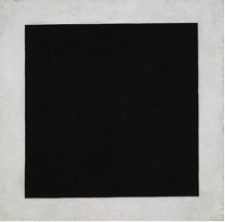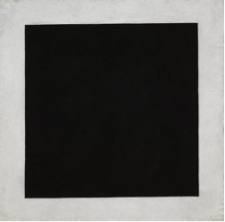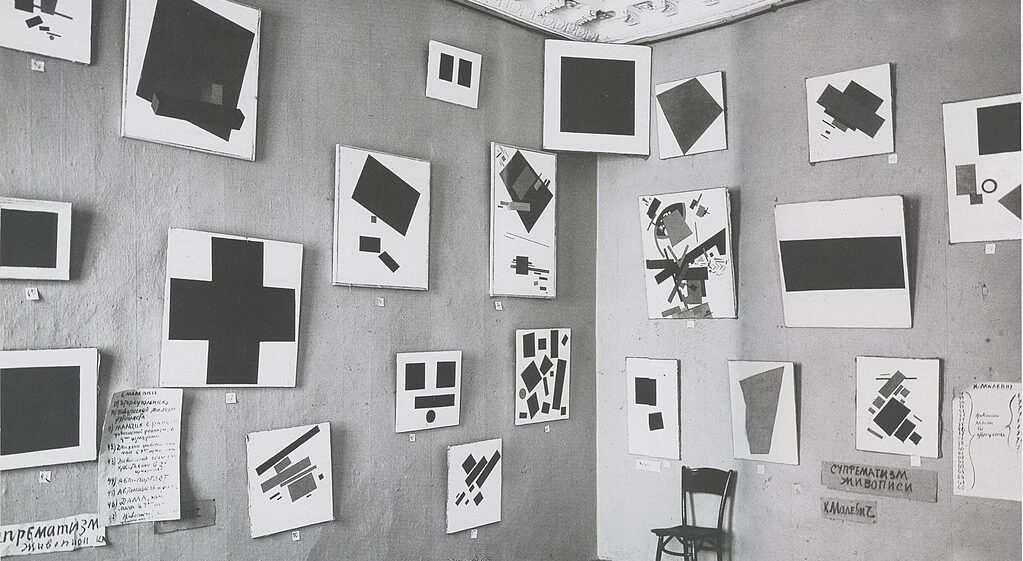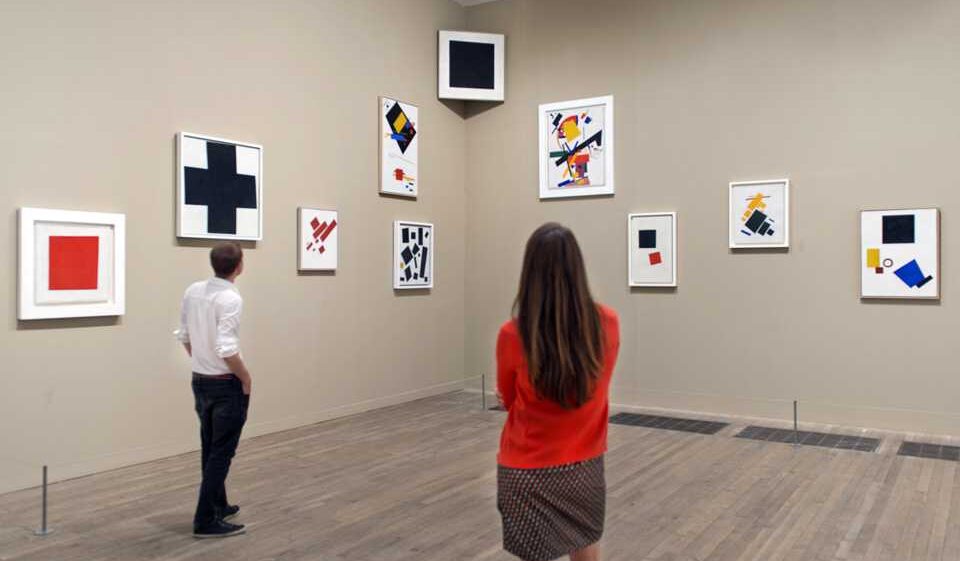
Preparing for Exploration
Why does a simple black square painted on a white background worth over $90 million?
The answer does not lie in the appearance of the artwork but in its lasting influence on art, culture, and society, and that’s something that even those who aren’t art experts can appreciate.
Imagine you are a business person passionate about art. Maybe you’ve heard of Bang & Olufsen (B&O), a Danish high-end consumer electronics company known for blending art and technology.
What’s truly intriguing is how B&O drew inspiration from an early 20th-century masterpiece in art history, despite the seemingly simplistic and childlike appearance of the artwork.
We’re talking about the “Black Square painted on a White Background”, by Kazimir Malevich (1879-1935).
Malevich, a Kyiv (Ukraine) born avant-garde artist (1) who studied art in Moscow (2), initially supported the Bolsheviks in Russia.
(1) The avant-garde period from 1905 to the mid-1920s, which included movements like Russian Futurism, was a time of innovative art with radical experimentation in painting, sculpture and film. It shaped world modern art.
(2) At that time, Kyiv was part of the Russian Empire until 1917 and later became part of the Soviet Union.
The “Black Square” painting had a significant impact on diverse fields, including designers, advertisers, architects, and companies like B&O.
Importantly, its insights offer ten valuable management lessons that Business Leaders can benefit from and use as inspiration to revisit critical areas for their company’s overall success.

Black Square is a 1915 oil on canvas painting (79,5 x 79,5 cm | 31,2 x 31,2 inches) by the Kiev-born artist Kazimir Malevich
Malevich’s four versions of ‘The Black Square’ are in Russia—its initial version (1915) is at Moscow’s State Tretyakov Gallery, and the second (1923) is at the State Russian Museum in St. Petersburg.
Valued at over $90 million on the secondary market, Malevich’s works are highly regarded in museum collections, such as the Museum of Modern Art and the Guggenheim Museum in New York, and the Stedelijk Museum in Amsterdam.
Malevich’s artwork represents one of the most transformative moments in modern art history, alongside the vibrant brushstrokes of the Impressionists, Cézanne’s binocular experiments, and Duchamp’s infamous use of a urinal as an art object (3).
Interestingly, the painting had a greater and more lasting influence in the West than the ideas of the Russian Revolution!
(3) Read Artcipation upcoming articles “Impressionist Movement: Seizing Tech, Social, and Political Disruptions” and “Duchamp’s Urinal: A Market Expansion That Leaves Leaders Impressed”
* * *
Malevich´s Black Square disrupted art, profoundly impacting society. Bang & Olufsen has been pioneering the blending of art and tech since the 1960s. Immerse yourself in their inspiring story.
Part 1 – The Black Square painting Artistic Disruption and its Ripple Effect on Business
As its name suggests, the painting consists of a Black Square on a white background. Its fascinating history provides valuable insights for industry market anticipation and for business leaders.
Kazimir Malevich (Ukrain-Kylv, 1878 – Russia-Saint Petersburg, 1935) first exhibited his “The Black Square” in 1913, as a stage curtain for the futurist opera “Victory over the Sun”.
The opera was created by prominent members of the Russian Futurist movement (4), with Malevich designing Cubo-Futurist costumes and stage sets. The use of a new language named “zaum” in the opera’s libretto was a particularly bold move, challenging the very foundations of language and communication.
(4) Russian Futurism was a part of the Russian avant-garde, and is the broad term for a movement of Russian poets and artists who adopted the principles of Filippo Marinetti´s “Manifesto of Futurism” (1909), which espoused the rejection of the past, and a celebration of speed, machinery, violence, youth, industry, destruction of academies, museums, and urbanism.

Stas Namin’s theatre, Moscow, 2014Cc Wikipedia / Shakko
The opera aimed to create a new world by capturing the sun and destroying time, rejecting the past, traditional norms of society, and conventional thinking. There was a growing sense of unease among the members of the movement regarding some side effects of modernization. This time period was marked by global chaos due to the imminent outbreak of the First World War and ongoing unrest following the 1905 Russian Revolution, which ultimately led to the Bolshevik uprising and the October Revolution of 1917.
Trotsky, Lenin, and Stalin conspired to establish a new government based on Karl Marx’s communism. The destruction of existing institutions was essential to the establishment of communism and the creation of a new (egalitarian) society.
Russian avant-gard artists deeply studied and admired the transformative work of their Western counterparts like Picasso, but they started to question their ability to meet emerging challenges and fulfill the world’s need to create a new society.
Inspired by these trends and the spirit of linguistic experiments in ‘Victory Over the Sun,’ Malevich created a new painterly language comprised solely of shapes and colors.
It was the first time someone had made a painting that didn’t depict anything, forever altering the notion that painting must represent reality and tell a story (e.g. by representing a person, an object, a scene, or landscape), breaking away from a tradition in art that dates back to prehistoric cave paintings. He named this language Suprematism.
Malevich´s groundbreaking painting approach heralded a disruptive era in modern art. By
discarding all traditional art themes and visual references to the tangible world, he liberated viewers to experience non-objectivity and the power of pure sensation, unrestrained by the limitations of past external influences
| Mark Rothko (Latvia 1903 – USA 1970) and Jackson Pollock (USA 1912-1956) are famous artists whose paintings evoke strong sensations in viewers, and are clear examples of the evolution of Malevich’s new artistic language. |
To avoid any influence from past experiences, Malevich went to the extreme of not signing his abstract works, allowing the viewer to have a pure experience and sensation, separate from preconceived notions or associations based on his earlier pieces.
Malevich worked on the theme between 1913 and 1915, and the developed works were shown in an exhibition that would gain significant renown. It was a collective exhibition held in St. Petersburg in 1915 and titled “The Last Futurist Exhibition: 0.10” (pronounced “Zero-Ten”).
The Russian avant-garde artists sent a message to the world with their “Zero point of painting” (0.10), a new phase in modern art that emerged from Zero to Suprematism and new realism. This movement removed recognizable themes and links to the past, emphasized non-objective creation, and valued the supremacy of sensibility over the object.
The number 10 (0.10) refers to the ten original artists who had been selected to exhibit (they ended up being fourteen).
The exhibition featured thirty-nine vibrant paintings showcasing Malevich’s original style of expression, Suprematism. This pure abstraction consists of one or two scattered geometric forms on a white background. Each square, rectangle, triangle, or circle is primarily painted in bold primary colors such as black, red, yellow, and blue (5).
Positioned high up in the corner of the room, the Black Square held a significant location alluded to its iconic status according to Malevich.
(5) Please refer to the Article “Seurat’s Color Mastery & the Value of Accumulated Knowledge in Corporations”
Although this may not hold much meaning for non-Russian viewers, traditionally, it was a sacred spot reserved for a Russian Orthodox icon of a saint in a Russian home. By placing the Black Square in this “icon corner,” Malevich emphasized its collision with traditional Orthodox culture.
Malevich aimed to make the Black Square the standout piece of the exhibition and convey its spiritual significance as the quintessential symbol of his innovative style. Essentially, he was conveying that the Black Square was the most iconic work on display and would continue to hold that position.
The 0.10 Exhibition
As a work of art, the Black Square is a striking example of how even a seemingly simple and childlike piece can have a profound impact on the course of art history.
It’s worth noting that at the 0.10 exhibition, Vladimir Tatlin (1885-1953), another Ukrainian artist and colleague of Malevich in a St. Petersburg artist society, also gained worldwide recognition for his disruptive approach to traditional sculpture art, and profound influence on future generations of artists and entrepreneurs.
Tatlin’s three-dimensional sculptures broke with traditional art in that they were not intended to imitate or critique aspects of real life. Instead, they existed as autonomous objects, unconstrained by the traditional art form of being mounted on pedestals, being physically solid and made of a single material such as stone or bronze, and not necessarily meant to be walked around.
This radical shift in approach was one of the defining features of the Russian Constructivist movement, of which Tatlin was a leading figure.
While Ukrainian artists and Bolshevik politicians shared international ambitions, the former have greatly surpassed the latter in terms of global influence and longevity.
But the beginning of their journey was not without difficulties: “Victory over the Sun” and the 0.10 Exhibition, both of which premiered in Saint Petersburg, were controversial and faced hostility from some viewers and critics.
How did we get here?
The emergence of Black Square painting was a natural progression in the evolution of art, which began as a response to photography with the advent of contemporary art.
Since its inception, contemporary art has increasingly eliminated realistic and narrative elements from its works to highlight other dimensions. Impressionists like Édouard Manet (1832-1883) focused on light and atmosphere, while Fauvists such as Henri Matisse (1869-1954) used bold colors to convey emotion and expression.
In a later stage, Artists considered pioneers of abstract art, such as Russian Wassily Kandinsky (1866-1944) and German Paul Klee (1879-1940), eliminated objective references to reality but, unlike Malevich, still included subtle signals or narrative elements in their paintings. For instance, Kandinsky used musical symbolism like a baton or a musical note to guide viewers.
On the other hand, Malevich’s Black Square represents the natural evolution of contemporary art, where the traditional relationship between the artist and the viewer has been inverted. In the past, the artist was subservient and existed to document, inspire, and beautify on behalf of the established order. However, with the rise of abstraction in art, artists like Kandinsky began to challenge this idea by inviting viewers to engage with their work and interpret its meaning.
Malevich’s non-objective art takes this concept to its ultimate conclusion by removing any vestiges of narrative or recognizable forms, forcing viewers to confront the artwork on its own terms. This approach highlights the importance of the viewer’s interpretation and engagement with the artwork, rather than relying solely on the artist’s interpretation.
Malevich’s Lasting Influence on Business and Contemporary Aesthetics
Malevich’s abstract art and subsequent Minimalism have led to a cultural shift towards modern designs that highlight simplicity, geometry, and color.
These elements are now ubiquitous and often taken for granted, but owe their existence to Malevich’s pioneering work. His impact on the business world has been significant, with his minimalist, abstract style influencing everything from product design to branding and marketing.
One of the most iconic companies that Malevich, with his “Black Square” painting, had influenced is Bang & Olufsen, a company known for creating elegant and minimalist high-end consumer electronics products that blend art and technology (please refer to Part 2 of this article: Malevich and Bang & Olufsen – Art And Tech Interwined (coming soon – Join the Artcipation Mailing List).
But his works have also influenced art directors and graphic designers like Peter Saville CBE (UK, 1955 – …). Saville designed many record sleeves for Factory Records. In a recent interview Saville discussed the inspiration behind his iconic designs (Frieze, 2019):
“I left the library with a stack of books. In one of them, I saw a black thing: Kazimir Malevich’s Black Square. When I saw it, I knew it was important, but I didn’t know why. I realized I didn’t know anything. That was the day my education started”.
The current logos of the Brasília and London subways, the works of fashion designer Tom Ford, and the design of modern furniture such as the iconic “Red and Blue” chair by Gerrit Rietveld all demonstrate the influence of Malevich´s works. This style is also prevalent in contemporary architecture, with buildings featuring clean lines and geometric shapes.
But, one of the most visible examples of Malevich’s pioneering abstract and subsequent minimalist style can be seen in the clean, minimalistic design of Apple’s products and the use of geometric shapes, colors, and negative space in iOS commands (7)
(7) Please refer to the Artcipation´s article “Picasso decisive impact on Apple´s Success: a Bull, a Mouse and Three Principles
Often, people tend to focus solely on the Russian Futurist movement’s impact on design and creativity, but it offers equally important value management insights that business leaders can benefit from and use as inspiration to revisit critical areas for their company’s overall success.
Ten Valuable Leadership Insights:
- Redesign your business model from a “zero point of painting” perspective when the business context undergoes structural shifts such as changing customer priorities, ESG, or the emergence of new technologies (e.g., AI). Remember that merely applying AI to an end-of-life-cycle business model will lead to an AI business model at the end of its life cycle;
- Simplify complex concepts or processes, it’s worthwhile but requires hard work and a deep understanding of the subject matter, as the Group of St. Petersburg Artists had shown. As the French philosopher and mathematician Blaise Pascal once said: ‘I apologize for writing you a long letter, as I didn’t have time to write a short one’;
- Stay persistent and flexible when innovating, as in every industry, there will always be pessimists and some hostility from critics, but be adaptable enough to change course when necessary. The controversy of “Victory Over the Sun” didn’t stop Malevich, as he explored new partnerships and channels to convey his message;
- Investing in two contrasting geniuses’ work relationship can yield exponential success, as seen in the case of Malevich-Tatlin in art, in Apple’s Steve Jobs and Steve Wozniak, or Spotify’s Martin Lorentzon and Daniel Ek.
- Mingling with people from diverse backgrounds can enrich a company’s vision and execution, as demonstrated by Malevich´s collaboration with not only Tatlin but also with a prominent poet, a musician, and a playwright in the Futurist Opera.
- Identify the “high up in the corner of the room” locations in your company/market and display both institutional and personal power politics icons, along with the company’s icons that represent your business mission, values, and value proposition for clients.
- Building partnerships and choosing the right partners is essential for business success. Just as Malevich couldn’t achieve success alone, a business rarely thrives without forming successful partnerships;
- Offering a self-segmentation option allows clients to personalize their experience and shape their interaction with your company. This approach, akin to Malevich’s inversion of the viewer’s role in art history, is illustrated by Dell, a pioneer in enabling clients to design their own PCs, and Tesla, which lets customers customize parts of their cars;
- Developing emotional connections with customers to build a stronger bond with your brand. This is similar to how painters like Mark Rothko can evoke strong emotions in viewers through their art. High-end brands like Louis Vuitton are renowned for creating emotional connections, while Nike’s iconic “Just Do It” slogan empowers athletes, making it a beloved brand.
- Believe that you can have an impact on the world, even if you’re not at its center. Despite being outside of Paris, the epicenter of the early 20th century art world, the artists of St. Petersburg made an indelible mark on art history.
Bang & Olufsen is an eccentric and visionary company that has taken design and technology to unparalleled heights. They have excelled in almost all of the areas mentioned above. I hope you find their inspiring story enjoyable (please refer to Part 2 of this article – Bang & Olufsen – Art and Tech Intertwined)
Quirk and Curiosities
Two of Malevich’s co-authors of the opera, Aleksei Kruchenykh, the poet who created a new language, and Mikhail Matyushin, who composed the music, were also involved with Malevich in creating the manifesto called “A Slap in the Face of Public Taste of the Capitalist World” in 1912.
This manifesto was considered one of the most important texts of the Russian Futurist movement. It was a declaration of artistic independence and a rejection of traditional art forms and values.
This rejection of tradition led to the birth of the radical Suprematism movement, which was launched by Malevich in his manifesto “From Cubism and Futurism to Suprematism in Art” in 1915.
Malevich painted four Black Squares, the last one around the late 1920s-early 1930s. The first version was probably painted in 1915, but dated 1913, to secure his place as the abstract art pioneer.
In addition to the Black Square, Malevich produced the Black Circle and Black Cross, featuring pure geometrical figures in primary colors on white backgrounds. These were his most well-known early works featuring pure geometrical figures in primary colors
Malevich and Tatlin’s strained relationship reached a climax at the “0.10” exhibition, allegedly resulting in physical violence. Tatlin had placed his sculpture “Corner Counter-Relief” in the corner, but Malevich’s decision to copy the idea with his Black Square diminished the impact of Tatlin’s work. This clash between two geniuses who disrupted the art world underscores the importance of keeping such talent together instead of splitting them apart or abandoning them.
While he did have some sympathy for the Bolsheviks’ ideas in the early years, his association with the movement was complicated, and his later works were not considered to align with Soviet realism.
Persecuted by Stalin, his work disappeared from view after his 1935 death. State-sponsored social realism became the official art of Russia. The Black Square was not exhibited until the 1980s and became a near-mythical icon, obscured from view.
The Black Square became Malevich’s motif, even his logo or trademark. In his later work, when he made a return to figurative paintings, he signed many of them with a little black square.
When Malevich died, he was buried in a coffin decorated by Nikolai Suetin with a black square at the head and a black circle at the foot.
The Black Square became not only an icon of Malevich’s style but also an icon of twentieth-century art.
There are several versions of Kazimir Malevich’s ‘Black Square,’ all housed in Russia. The original resides in the State Tretyakov Gallery in Moscow, while the 1923 rendition is located in The Russian Museum of St. Petersburg. Additionally, the 1929 version can be viewed at the New Tretyakov Gallery, also in Moscow. Beyond Russia, you can explore Malevich’s Suprematist paintings at renowned institutions like the Guggenheim Museum or the Museum of Modern Art in New York City, as well as the Stedelijk Museum in Amsterdam.
I’m sure you’ll now look at it with an even more exciting perspective.
Malevich´s Black Square disrupted art, profoundly impacting society. Bang & Olufsen has been pioneering the blending of art and tech since the 1960s. Immerse yourself in their inspiring story in Part 2.
Part 2 – Malevich and Bang & Olufsen – Art And Tech Interwined (coming soon – Join the Artcipation Mailing List)
Jose Taboada – Founder of Artcipation | Corporate Strategist
Comment Article on:
Subscribe our Mailing List today!







Leave a Reply